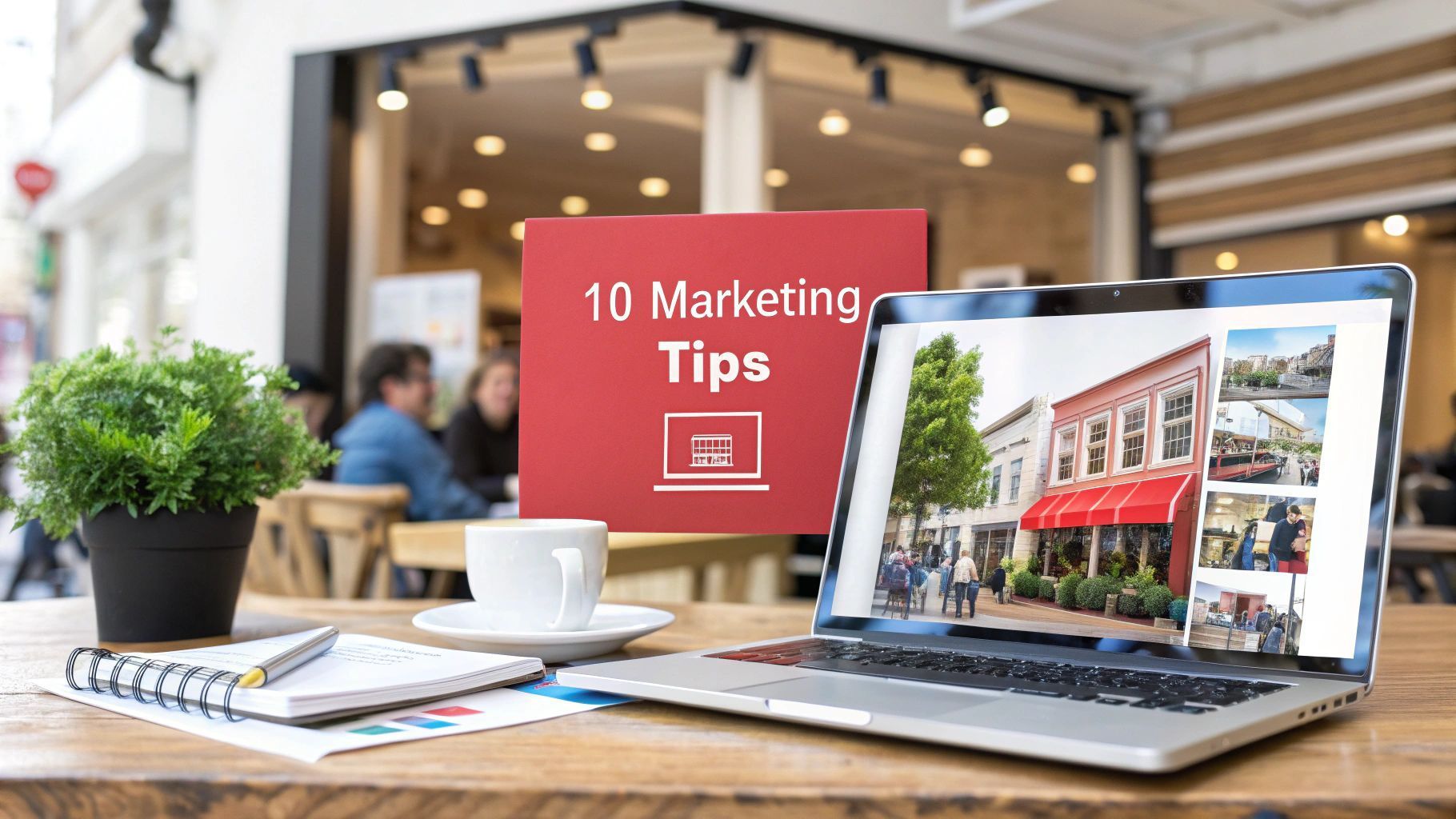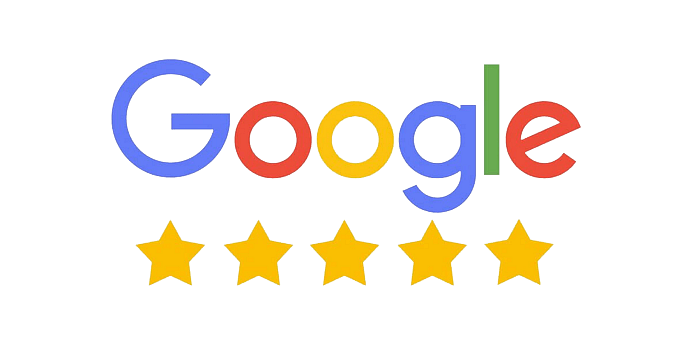Local SEO for Small Businesses A Growth Playbook
Local SEO is your secret weapon for getting found by the people who matter most: customers in your immediate area who are actively looking for what you sell. It’s all about fine-tuning your online presence so you show up in those all-important local search results like Google Maps and the “local pack”, turning clicks into actual customers walking through your door.
Why Local SEO Is Your Biggest Opportunity
Not so long ago, businesses relied on word-of-mouth, flyers and a spot in the local paper. While those still have a place, the game has completely changed. Today, the customer journey almost always starts online.
Just think about your own habits. When you need a plumber, fancy a coffee or need a solicitor, what’s the first thing you do? You grab your phone and search.
This fundamental shift is why local SEO for small businesses is no longer a “nice-to-have”—it’s an absolute must. It’s the digital equivalent of having the best spot on the high street. If you’re not visible when local customers are searching, you’re basically invisible to them.
Connecting with High-Intent Customers
The real magic of local search is the intent behind it. Someone searching for "emergency plumber in Bristol" isn't just browsing; they have a problem that needs solving right now. They are a red-hot lead, ready to make a decision and spend money.
By getting your business to the top of those results, you become the most obvious, convenient solution at the exact moment your customer needs you. It's not about casting a wide net and hoping for the best. To really get a handle on this, it's worth understanding location-based marketing and seeing how it directly feeds into local visibility. This is about precision targeting in your own backyard.
The Numbers Speak for Themselves
If you’re still not convinced, the data paints a very clear picture. The link between a local search and a sale is undeniable.
Here in the UK, a staggering 46% of all online searches have local intent. That means nearly half of all people using search engines are looking for local businesses. This online activity drives real-world action, with 76% of customers who search on their smartphone visiting a business within 24 hours . Even better, 28% of those visits lead to a purchase .
The table below breaks down just how powerful these local searches are for driving genuine business growth.
The Impact of Local Searches on Small Business Growth
This table summarises the critical statistics showing the direct link between local online searches and real-world business outcomes like shop visits and purchases.
| Consumer Action | Key Statistic | Implication for Your Business |
|---|---|---|
| Search with local intent | 46% of all online searches in the UK are for local information. | Nearly half of your potential customers are searching for businesses like yours online. |
| Shop visit after search | 76% of local mobile searches result in a shop visit within 24 hours. | Your online presence directly translates to physical foot traffic, often immediately. |
| Purchase after visit | 28% of those local searches result in a purchase. | A significant portion of online searchers are not just browsing; they're ready to buy. |
These figures show a clear, profitable path from a simple search query to a sale for your business.
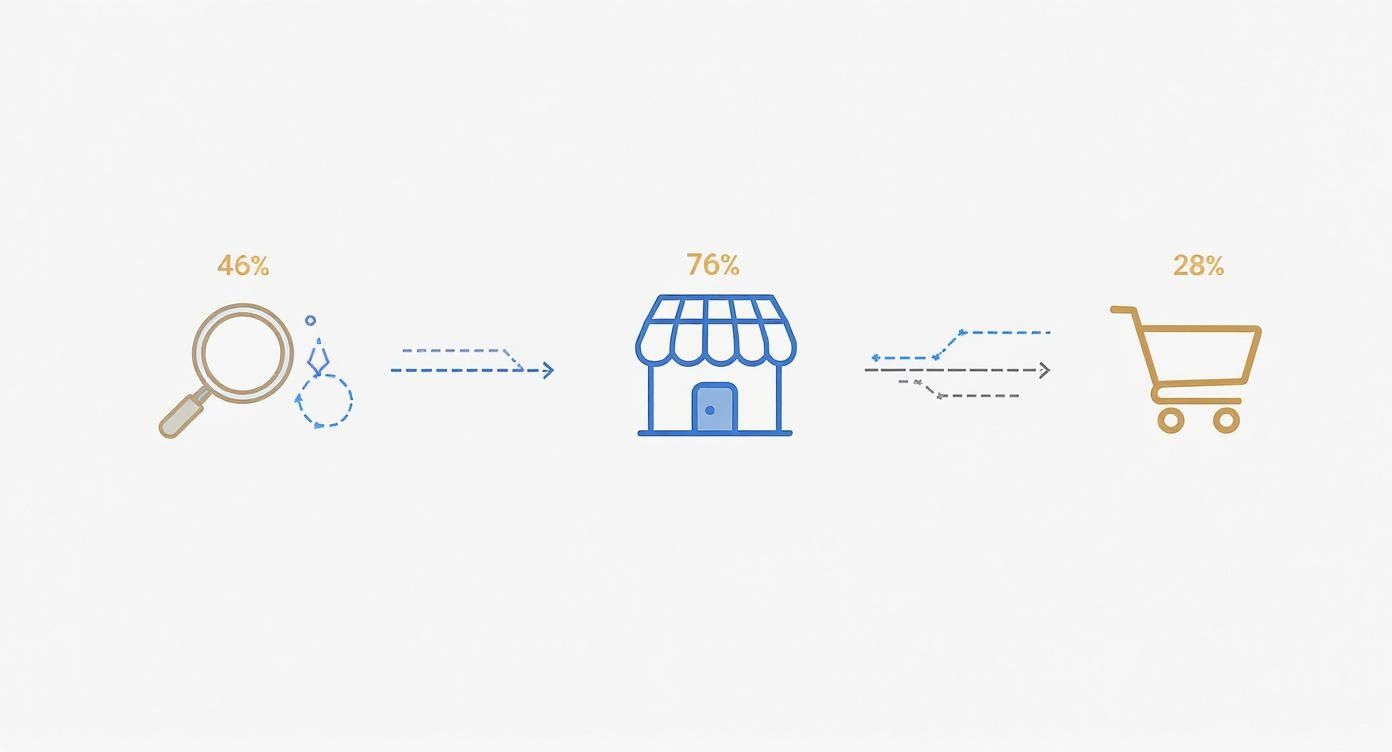
The journey is simple: they search, they find you, they visit and they buy.
By ignoring local SEO, you are essentially closing your doors to nearly half of the potential customers actively searching for your services. It's the most direct and cost-effective way to generate footfall and sales in your community.
Mastering Your Google Business Profile
If your business has a digital shopfront, your Google Business Profile (or GBP) is it. This isn't just another online directory; it's the single most powerful tool you have for winning over local customers.
When someone searches for "best cafe in Devon" or "emergency electrician near me", the information that pops up in that coveted map pack comes directly from these profiles. Getting it right is the central pillar of effective local SEO.
But getting it right goes far beyond just plugging in your name and address. A fully optimised profile is a dynamic advert for your business. It answers customer questions on the spot, shows off the quality of your work and convinces people to choose you over the competition down the road.
Don't Just Set It and Forget It
So many business owners create a profile, fill in the bare essentials and then let it gather dust. That's a massive missed opportunity. Your GBP should be a living, breathing part of your marketing that showcases what makes you special.
Let's start with a couple of critical areas that are so often overlooked.
- Business Categories: Be ridiculously specific here. Instead of just "Restaurant", choose "Italian Restaurant", "Pizzeria" and "Family-Friendly Restaurant" if they all fit. You get one primary category and can add several secondary ones. The more relevant categories you nail down, the more searches you can show up for.
- Services/Products: This is where you detail exactly what you do. A plumber shouldn’t just list "Plumbing". They need to add specific services like "Leaky Tap Repair", "Boiler Installation" and "Blocked Drain Clearance". This simple step helps Google match you to highly specific, high-intent customer searches.
By detailing everything you offer, you’re not just informing potential customers; you're feeding Google precise data it can use to rank you for valuable keywords that signal someone is ready to buy.
Crafting a Description That Connects
You get 750 characters for your business description. Think of it as your elevator pitch. It’s your chance to tell people who you are and, more importantly, why they should trust you with their money. Don't just list what you sell; tell a story.
A great description for a local bakery might talk about its family-run history, its use of locally sourced ingredients or its award-winning sourdough. This creates a human connection that a sterile list of products just can't match. Weave in your main local keywords naturally, like "artisan bakery in York", to give Google an extra nudge.
A well-crafted GBP is one of the strongest signals you can send to Google about your business's relevance and authority in a specific local area. It’s a direct line of communication to both the search engine and your future customers.
The data doesn't lie. A fully optimised Google Business Profile is a huge ranking factor. In fact, UK businesses with keyword-rich descriptions in their GBP profiles see a 31% improvement in their local map pack visibility. Profiles that are regularly updated with new posts and photos also appear far more often in the top results. You can see the full picture on GBP's impact for yourself.
Get Active and Engage Your Audience
Your GBP is not a static brochure; it's an interactive platform. The businesses that really win are the ones that use its engagement features to their full potential. This is what separates a good profile from a great one.
Here’s how to turn your profile into a tool that actively brings in customers.
- Use Google Posts: Think of these as a mini-blog right on your profile. Share special offers, announce new products or showcase a project you just finished. An electrician in Manchester could create a Post with photos of a recent smart home installation, instantly reinforcing their expertise. These posts do expire, so try to add a new one every week to keep things fresh.
- Encourage and Answer Questions: The Q&A feature lets customers ask questions directly on your profile. Don't wait for them. Proactively seed this section by asking and answering common questions yourself. For instance, a cafe owner could post the question, "Do you have gluten-free options?" and then answer it with, "Yes, we have a fantastic range of gluten-free cakes and bread available daily!"
- Upload High-Quality Photos and Videos: Visuals are everything. Regularly add clear, high-resolution photos of your shop, your team at work and your products. A short video tour or a quick testimonial from a happy customer can have a huge impact.
Managing all of this takes consistent effort, but the return is more than worth it. If you need a hand turning your profile into a lead-generating machine, our team can help you build a Google Business Profile page that gets more business from Google. This consistency signals to Google that you're active, reliable and deserving of that top spot.
Building Trust with Reviews and Citations
Once your Google Business Profile is polished, it’s time to focus on the real currency of local trust: social proof. For any small business hoping to climb the local search rankings, this trust rests on two critical pillars: what your customers say about you (reviews) and how consistently your business details appear online (citations).
Think of it this way. Reviews are the new word-of-mouth. When a potential customer sees a string of recent, positive reviews, it immediately signals that you're a safe bet. Citations, on the other hand, act like digital signposts, reinforcing your legitimacy every time Google sees your business mentioned correctly in a trusted online directory.
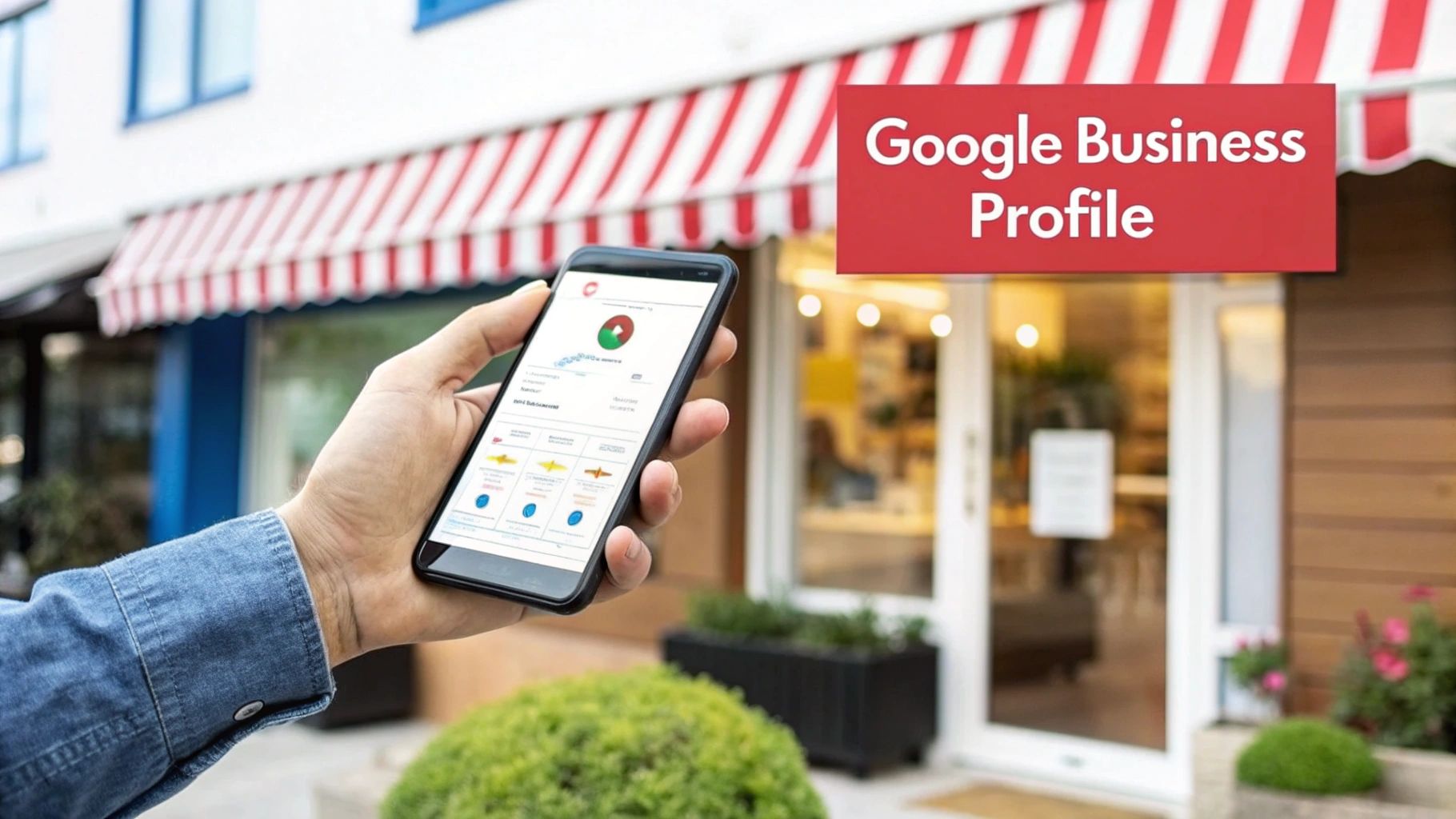
The Art of Encouraging and Managing Reviews
Getting a steady stream of reviews isn't about luck. It’s about having a simple, repeatable process. While most happy customers are willing to leave feedback, they almost always need a gentle nudge.
The golden rule? Ask right after a positive experience. Whether you’ve just finished a job, served a fantastic meal or sold a product they love, that moment of satisfaction is your window of opportunity.
Here are a few straightforward ways to make the ask:
- Email or SMS Follow-up: A simple, personalised message sent a day after service can work wonders. Crucially, include a direct link to your Google review page to make it effortless for them.
- QR Codes: Pop a small sign with a QR code on your counter, van or invoices. A quick scan with a phone takes the customer straight to your review page. No fuss.
- A Personal Request: Never underestimate the power of simply asking. For tradespeople like plumbers or electricians, a friendly "If you were happy with the work, we'd really appreciate a review" upon completion is often the most effective method of all.
Responding to reviews is just as vital as collecting them. Always thank customers for their positive feedback. For negative comments, respond professionally and constructively. It shows you care about every customer's experience and are committed to great service. To earn stellar local reviews and build trust, delivering exceptional customer service is paramount. Delve into top customer service best practices for small businesses to foster loyalty and positive word-of-mouth.
The Power of Consistent Citations
Now for the second pillar: citations. A citation is any online mention of your business’s N ame, A ddress and P hone number (NAP). You'll find them in online directories like Yelp, Yell and Thomson Local, as well as on niche, industry-specific sites.
Why does this matter so much? Because Google uses these citations to verify that your business is real, legitimate and actually located where you claim to be.
Inconsistent NAP information is one of the biggest red flags for Google's local algorithm. If one directory lists you as "Smith's Plumbing Ltd." on "High St" and another has "Smiths Plumbing" on "High Street", it creates confusion. This erodes trust and can directly hurt your rankings.
The name of the game is NAP consistency . Your business name, address and phone number must be identical everywhere. This painstaking attention to detail is what proves to search engines that your data is solid and reliable.
Conducting a Citation Audit and Cleanup
First things first, you need to see where your business is currently listed and hunt down any inconsistencies. A few simple searches for your business name and address will quickly reveal what's out there.
Once you have a list, your mission is to:
- Claim Your Listings: Find your business on the major UK directories and claim the profile. This usually involves a quick phone call or postcard verification.
- Correct Inaccuracies: Go through each claimed listing with a fine-tooth comb and fix every error in your NAP details. Pay close attention to small things like "St." vs. "Street" or "Ltd" vs. "Limited".
- Build New Citations: Identify relevant local or industry-specific directories where you're not yet listed and create new, perfectly accurate profiles. A local accounting firm needs to be in different directories than a local cafe.
This process can feel tedious, I know. But it's a foundational task that pays dividends for years to come. By ensuring your business information is clean and consistent, you're building a rock-solid base of trust with search engines that will support all your other local SEO efforts. For a deeper dive into this, you can learn more about how to boost your business SEO with local listings in our specialised guide.
Creating Website Content That Attracts Local Customers
Your Google Business Profile and online reviews are fantastic tools, but they almost always lead customers to one central place: your website. This is your digital home ground. It's the one space you have complete control over and it's where casual interest turns into genuine leads. For local SEO to really work, your website has to speak directly to the community you serve.
This means going way beyond generic service descriptions or a bland 'About Us' page. Your job is to create content that answers the specific questions and solves the unique problems of people in your area. You need to show them you’re not just a business, but their local business.
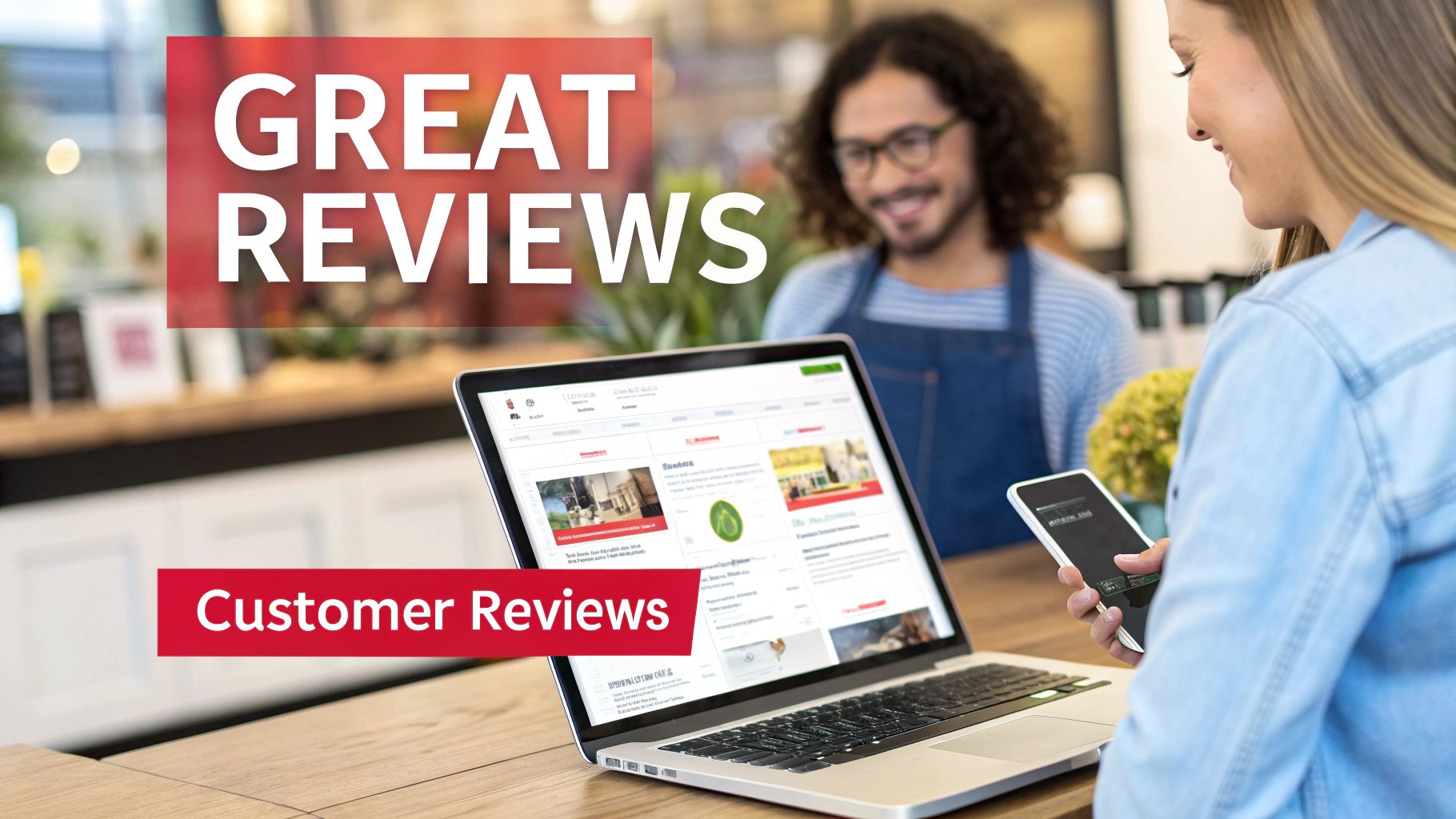
Build Dedicated Location and Service Pages
If you serve multiple towns or even distinct neighbourhoods, one of the most powerful things you can do is create separate pages on your website for each one. A single "Our Services" page just won't cut it if you're a plumber trying to attract customers from both Exeter and Torquay.
Instead, you’d create highly targeted pages like "Boiler Repair in Exeter" and "Emergency Plumber in Torquay". Each page needs to be filled with unique content that’s genuinely relevant to that place. Mention local landmarks, talk about common issues you see in the area (like hard water problems in certain postcodes) and sprinkle in testimonials from clients in that specific town.
This simple approach does two crucial things:
- It screams your location to Google. This is how you start ranking for those valuable "near me" searches, like "plumber in Exeter".
- It builds instant trust with local customers. When someone sees you understand their area, it creates an immediate sense of relevance, making them far more likely to pick up the phone.
Write Content That Answers Local Questions
Step into your customer's shoes for a moment. What are they actually typing into Google? They’re not just searching for "solicitor". They’re searching for things like "finding a trusted conveyancing solicitor in Bristol" or "best firm for will writing near Clifton".
Your blog and your service pages need to directly address these kinds of long, specific search queries. Create articles and guides that provide real value by answering these questions head-on.
The most powerful local content doesn't just sell; it helps. By becoming the go-to resource for local queries, you build authority and attract customers who are already looking for your expertise.
For example, a local financial advisor in Devon could write a blog post titled, "A Guide to Retirement Planning for Small Business Owners in Devon". It’s hyper-specific, incredibly useful to a niche audience and sends all the right local signals to search engines. For more inspiration, check out these content marketing strategies for small businesses on a budget to see how you can create high-impact content without breaking the bank.
Optimise Your On-Page SEO Essentials
Once you’ve got great local content, you need to make sure search engines can actually understand what it’s about. This is where on-page SEO comes in. It’s all about tweaking a few key elements on each page of your site.
Don't worry, you don't need to be a technical whizz. For the biggest impact, just focus on these two areas.
- Title Tags: This is the headline that shows up in the Google search results and in the browser tab. It needs to be clear, concise (keep it under 60 characters ) and include your main service and location.
- Meta Descriptions: This is the little snippet of text under the title in the search results. While it doesn't directly affect your ranking, a compelling meta description ( around 155 characters ) is your sales pitch to convince someone to click on your link instead of a competitor's.
Let’s see how this works for two different businesses.
| Business Example | Poor On-Page SEO | Good On-Page SEO |
|---|---|---|
| Local Bakery | Title:
Home Page Meta: We sell cakes and bread. |
Title:
Artisan Sourdough & Cakes | The Bristol Bakery Meta: Delicious, freshly baked sourdough bread, pastries and custom cakes in the heart of Bristol. Order online or visit our bakery on Gloucester Road. |
| Financial Advisor | Title:
Services Meta: We offer financial advice. |
Title:
Expert Pension & Investment Advice in Manchester | Smith Financial Meta: Need trusted financial advice in Manchester? We specialise in retirement planning and investment strategies for local residents. Book a free consultation. |
The difference is night and day, isn't it? The optimised versions are far more descriptive and appealing. They tell both Google and potential customers exactly what the page is about and where the business operates, making them hugely more effective at pulling in local traffic.
Common Local SEO Mistakes You Need to Avoid
Putting time and effort into a local SEO strategy is a fantastic move for any small business, but it's incredibly frustrating when those efforts don't seem to pay off. More often than not, this comes down to a few common—and costly—mistakes.
Think of this as your troubleshooting guide. We'll walk through the slip-ups I see all the time that hold businesses back from reaching their true potential online. By sidestepping these frequent errors, you can make sure your hard work actually translates into better visibility and more customers walking through your door.
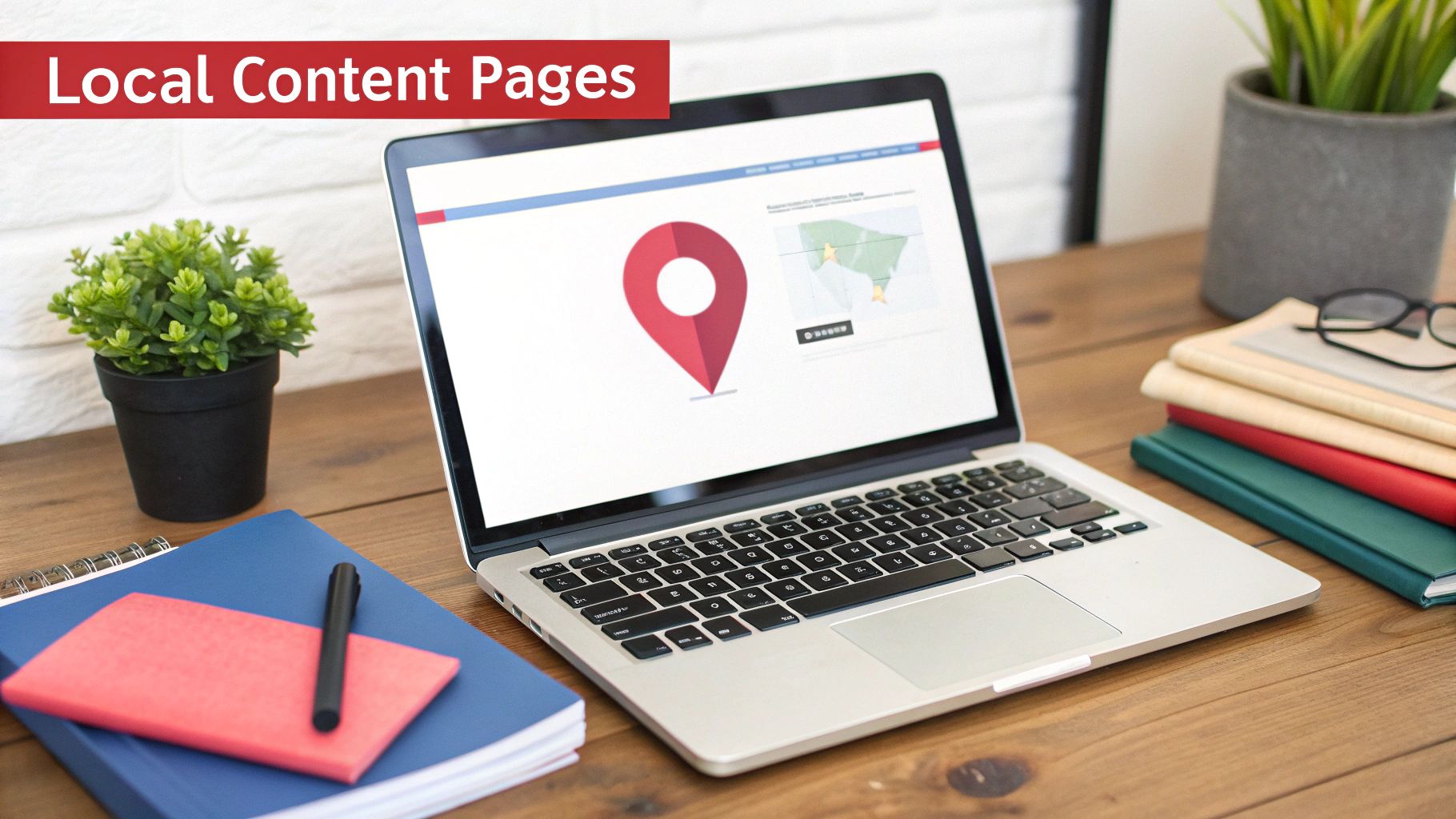
Neglecting NAP Consistency
One of the single most damaging mistakes is having inconsistent N ame, A ddress and P hone number (NAP) details scattered across the internet. For a search engine like Google, consistency equals credibility. It’s that simple.
Imagine one directory lists you as "Smith's Electrical Ltd." on "High St" but another has "Smith Electrical" on "High Street." This creates confusion and tells Google that your business information is unreliable, which directly torpedoes your ability to rank in local searches.
Your NAP has to be identical everywhere—your website, your Google Business Profile and every single online directory. This includes tiny details you might overlook, like "Ltd" versus "Limited" or "St" versus "Street."
Ignoring the Power of Reviews
Another classic error is underestimating just how much customer reviews matter. It's not enough to simply have a profile set up; you need a steady stream of fresh, positive feedback to build trust with both potential customers and search engines.
Ignoring reviews, good or bad, sends a clear signal that you aren't engaged with your community. On the other hand, businesses that actively ask for and respond to feedback show that they care about customer service and Google absolutely rewards that.
A business with a constant flow of recent, positive reviews is seen as a more trustworthy and relevant choice. If you're not managing your online reputation, you're essentially handing customers over to competitors who are.
The Problem with Duplicate Listings
It’s surprisingly easy for a business to end up with multiple Google Business Profiles without even knowing it. This can happen if an employee creates a new profile by mistake or sometimes Google automatically generates one based on other data it finds online.
Duplicate listings are a serious problem. They split your authority, customer reviews and SEO value between two or more profiles. This massively dilutes the power of your primary listing and confuses search engines, making it much harder for you to rank where it counts.
An Alarming Gap in Local SEO Adoption
Despite how critical these tools are, a shocking number of UK businesses just aren't using them. The latest research shows that only 35% of UK small to medium businesses (SMBs) even have an active Google Business Profile.
The figures are even worse for engagement with business directories ( 17% ) and online review sites ( 15% ). This highlights a huge gap in understanding just how powerful local SEO can be, causing countless businesses to miss out on connecting with customers right in their area. You can find more insights in the 2025 SMB marketing report on BrightLocal.
Keyword Stuffing and Unnatural Content
In a desperate rush to rank, some businesses fall into the trap of "keyword stuffing." This means cramming their website content and GBP description with as many location and service keywords as possible. You've probably seen it: "We are the best plumbers in London, offering London plumbing services and emergency plumbing in London."
This tactic is old-school and, frankly, it's harmful. Google’s algorithms are more than smart enough to spot this kind of unnatural language and it will earn you a penalty, not a better ranking.
Instead, your content should focus on providing genuine value to the reader. Describe what you do clearly and naturally. Write for humans first, search engines second.
By steering clear of these common traps, you’ll build a solid foundation for a local SEO strategy that delivers real, lasting results.
Your Local SEO Questions Answered
If local SEO feels like a bit of a mystery, you’re not alone. It’s often wrapped up in technical jargon but getting clear on a few key questions can make all the difference. The trick is to focus on realistic goals and consistent, daily actions.
Let's break down the common hurdles most small business owners face.
How Long Does Local SEO Actually Take to Work?
This is the big one, isn't it? While you might see small uplifts in profile views or website visits within a few weeks, the real, meaningful improvements—better rankings and more foot traffic—typically start showing up in three to six months .
Patience is key here. Think of it like this: a family-run bakery in York that updates its Google Business Profile with daily specials and actively asks every customer for a review is going to see faster gains than a competitor who only logs in once a month. Consistency really does move the needle.
Just be warned: trying to game the system with tactics like keyword stuffing will almost always backfire and end up hurting your visibility.
If you want to speed things up, focus on building good habits:
- Carve out time for a weekly content update on your GBP.
- Make sending a review reminder part of your process after every single completed service.
- Add a localised blog post to your website once or twice a month.
Consistency is the single most important factor in local SEO success.
Can I Do Local SEO Myself or Should I Hire an Agency?
You can absolutely manage the basics of local SEO yourself. In fact, you probably should.
Everyday tasks like optimising your Google Business Profile and responding to reviews are straightforward and incredibly powerful. Many small business owners find huge success just by following a clear roadmap and staying on top of these core activities.
That said, there comes a point where time constraints or a lack of technical expertise might have you looking for support. An agency can step in to handle the heavy lifting in competitive markets, from advanced citation building to in-depth website audits.
A blended approach often works best. You handle the day-to-day, which keeps you in control and helps you learn, while an expert tackles specialist projects like schema markup or local link outreach.
Here’s a quick look at the key differences:
| Task | DIY | Agency |
|---|---|---|
| Google Business Profile Updates | ✔️ | ✔️ |
| Advanced Technical SEO | ✖️ | ✔️ |
| Ongoing Performance Analysis | Optional | Included |
| Budget Range | £0–£100/month | £500–£2000/month |
This way, you can transition smoothly from in-house efforts to agency support as your business grows and your needs change.
What’s the Difference Between SEO and Local SEO?
Think of traditional SEO as casting a huge net across the entire internet. It’s designed to help you rank nationally or even globally for broad search terms.
Local SEO, on the other hand, is like casting a very focused net right in your own community. It prioritises location signals, like the accuracy of your Google Business Profile and local citations, to attract customers nearby.
While both rely on things like on-page and off-page optimisation, local SEO adds that crucial geographic layer. Searches that include phrases like ‘near me’ or a specific postcode trigger Google’s local search algorithm. Suddenly, things like your precise address details and local reviews become the most important signals.
To put it simply:
- Traditional SEO targets broad search volume; local SEO targets search intent within a specific area.
- Link quality matters for both, but local citations are a unique and vital part of local SEO.
- On-page content for traditional SEO uses broader keywords, while local SEO leans into location-specific phrases.
How Much Should I Budget for Local SEO?
Here’s the good news: many of the most effective local SEO tactics are completely free.
Claiming and verifying your Google Business Profile costs nothing but your time. The same goes for encouraging customer reviews and creating your own localised content. All it takes is effort, not a financial outlay.
As your demands grow, you might choose to invest in tools or professional help. Keyword research tools can start from around £50/month , while an agency retainer for ongoing management typically ranges from £500 to £2000/month .
The formula is pretty simple: the more competitive your local market, the more investment you’ll likely need to stand out from the crowd.
For a budget-friendly start, I’d suggest:
- Using free tools like Google Search Console and Analytics.
- Paying attention to the built-in keyword suggestions in your GBP.
- Setting up simple email templates to schedule your review follow-ups.
- Keeping an eye on performance metrics to see what’s working and adjust your strategy accordingly.
A small time investment today can save significant marketing costs tomorrow.
Ready to amplify your local visibility? Partner with Superhub to accelerate your growth and dominate local search results now at https://www.superhub.biz


